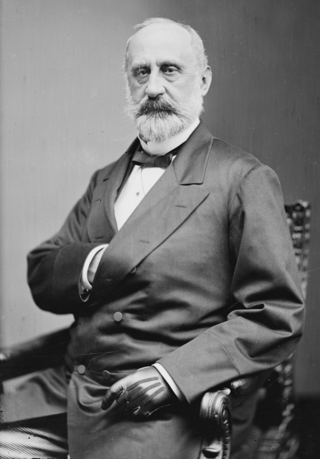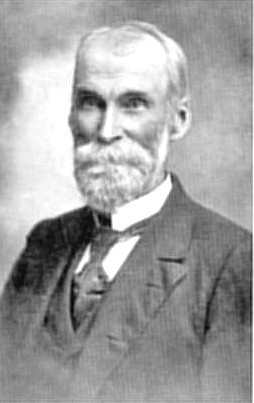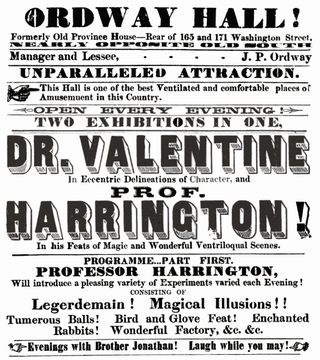
Charles Devens Jr. was an American lawyer, jurist and statesman. He also served as a general in the Union Army during the American Civil War.

Donald McKay was a Canadian-born American designer and builder of sailing ships, famed for his record-setting extreme clippers.

Walter Kittredge, was a famous American minstrel and songwriter. Over his career he wrote over 500 songs, many of them dealing with themes of abolitionism and the American Civil War, the most famous of which was Tenting on the Old Camp Ground.

James Lord Pierpont was an American songwriter, arranger, organist, Confederate States soldier, and composer. Pierpont wrote and composed "Jingle Bells" in 1857, originally titled "The One Horse Open Sleigh".

Henry Ward Poole (1825–1890) was an American surveyor, civil engineer, educator and writer on and inventor of systems of musical tuning. He was brother of the famous librarian William Frederick Poole, and cousin of the celebrated humorist, journalist and politician Fitch Poole.
William Arms Fisher was an American composer, music historian and writer.

Charles Crozat Converse was an American attorney who also worked as a composer of church songs. He is notable for setting to music the words of Joseph Scriven to become the hymn "What a Friend We Have in Jesus". Converse published an arrangement of "The Death of Minnehaha", with words by Henry Wadsworth Longfellow.

Oliver Ditson was an American businessman and founder of Oliver Ditson and Company, one of the major music publishing houses of the late 19th century.

William J. Johnston was a drummer boy in Company D of the 3rd Vermont Infantry during the American Civil War. When his division was routed during the Seven Days Battles during the Peninsula Campaign of June to July 1862, he was the only drummer to come away with his instrument. His superiors considered this a meritorious feat, given that the regiment's other soldiers had thrown away their guns and equipment to lighten their loads as they retreated. As a result, he received the Medal of Honor in 1863; at age 13, he remains the youngest recipient of the award.

The Boston Museum (1841–1903), also called the Boston Museum and Gallery of Fine Arts, was a theatre, wax museum, natural history museum, zoo, and art museum in 19th-century Boston, Massachusetts. Moses Kimball established the enterprise in 1841.

Alexander Rice Esty was an American architect known for designing many Gothic Revival churches in New England. His work also encompassed university buildings, public buildings, office buildings, and private residences across the Northeastern United States.

Ordway Hall (est.1852) was a theatre in Boston, Massachusetts located off Washington Street in the former Province House. John P. Ordway established and managed the hall, which specialized in "negro minstrelsy," particularly the Ordway Aeolians, his own troupe.

Norwood Penrose "Pen" Hallowell was an officer in the Union Army during the American Civil War. One of three brothers to serve with distinction during the war, he and his brother Edward Needles Hallowell both became commanders of the first all-black regiments. He is also remembered for his close friendship with and influence upon future Supreme Court justice Oliver Wendell Holmes Jr., who was his classmate at Harvard and his comrade during the war.

Francis Boott was an American classical music composer of art songs and works for chorus.

George Partridge Sanger was an American lawyer, editor, judge, and businessman who served as the United States Attorney for the District of Massachusetts from 1873 to 1886 and was the first president of the John Hancock Mutual Life Insurance Company.

George Washington Jackman Jr. was an American shipbuilder and politician from Newburyport, Massachusetts.

Florence Atherton Spalding was an American music teacher and a composer from Boston, Massachusetts.

William A. Penno (1843–1929), known by his stage name William A. Huntley, was a composer, music teacher, and vocal and instrumental performer in minstrel and vaudeville traditions. Playing his 5-string banjo before crowds that came to number in the low thousands, he sang in a high tenor and played his banjo bare fingered, picking the strings in a style today named "classic banjo." His published compositions include banjo instrumentals and parlor music. Huntley spent his working life performing and teaching in the off season. He performed throughout the United States and toured Europe as a part of several different minstrel groups. A highlight of his performing career was to play before the Prince and Princess of Wales, about 1880 at Her Majesty's Theatre in London. He moved away from minstrel shows by the 1880s, and "took pride" that he could perform without blackface stage makeup. He focused on building respectability for the banjo, through teaching, composition, and performance recitals. He was featured in the S. S. Stewart Company's catalog and began to play the company's banjeaurine. In 1888 he performed before a crowd of 2,000 people in his hometown, Providence, Rhode Island.

Mary Andrews Denison was an American novelist. She wrote over eighty novels which in total sold more than one million copies. Her writing style was typical of the dime novels popular in the mid-nineteenth century, featuring sweet-natured and noble heroines who triumph over evil.


















